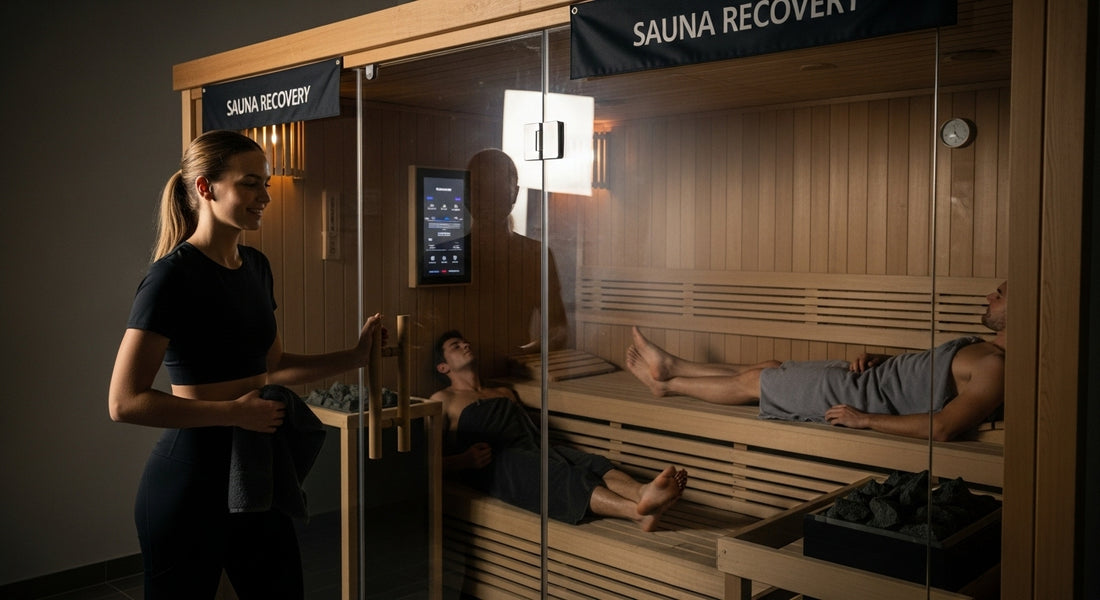
Understanding Sauna as Part of Recovery for Wellness
Saunas are often seen as a place to unwind, but modern research reveals a much deeper impact. Imagine this—athletes who add sauna sessions to their routines can see a 32 percent increase in run time to exhaustion. That might sound unbelievable for such a simple ritual. Yet the real surprise is how sauna therapy creates complex changes across your entire body and mind, setting the stage for recovery in ways most people never expect.
Table of Contents
- What Is A Sauna And How Does It Relate To Recovery?
- Why Incorporating Sauna Into Recovery Routines Matters?
- How Sauna Therapy Works At A Physiological Level?
- Key Concepts Of Sauna Use For Relaxation And Recovery
- Real-World Applications Of Sauna In Recovery Practices
Quick Summary
| Takeaway | Explanation |
|---|---|
| Saunas enhance physical recovery | Sauna use significantly aids muscle recovery by promoting relaxation and reducing soreness. |
| Saunas improve cardiovascular function | Heat exposure boosts heart rate and circulation, enhancing overall cardiovascular health and endurance. |
| Saunas support mental wellness | Regular sauna use helps reduce stress levels by decreasing cortisol and enhancing relaxation. |
| Saunas activate cellular repair mechanisms | The heat stimulates heat shock proteins, promoting cellular repair and metabolic efficiency. |
| Athletes benefit from regular sauna sessions | Incorporating saunas into training routines can improve endurance and recovery times significantly. |
What is a Sauna and How Does it Relate to Recovery?
A sauna represents a specialized heated space designed to induce therapeutic sweating and promote profound physiological relaxation. As part of recovery protocols, saunas offer a strategic approach to healing and wellness that goes far beyond simple heat exposure.
Understanding Sauna Fundamentals
Saunas are enclosed spaces typically constructed from wood, maintained at high temperatures ranging between 150 to 195 degrees Fahrenheit. These environments trigger significant bodily responses that support physical and mental recovery. According to Mayo Clinic Proceedings, sauna sessions can produce multiple health benefits by stimulating cardiovascular and neurological systems.
Key physiological responses during sauna use include:
- Increased heart rate similar to moderate cardiovascular exercise
- Enhanced blood circulation throughout the body
- Activation of heat shock proteins that support cellular repair
- Stimulation of the autonomic nervous system
Recovery Mechanisms in Sauna Therapy
Sauna therapy functions as a powerful recovery tool by creating controlled stress on the body that ultimately promotes healing. When exposed to intense heat, the body initiates multiple adaptive responses. Research published in PubMed demonstrates that sauna sessions can significantly modify neural network arousal, potentially improving cognitive performance and supporting mental recovery.
The recovery benefits emerge through several interconnected mechanisms:
- Muscle relaxation and tension reduction
- Accelerated metabolic processes
- Improved lymphatic drainage
- Enhanced mitochondrial function
Athletes, wellness practitioners, and individuals seeking comprehensive recovery strategies increasingly recognize saunas as a sophisticated intervention for holistic health maintenance. By strategically incorporating sauna sessions into recovery protocols, individuals can support their body’s natural regenerative processes and optimize overall wellness.
Below is a table summarizing the key physiological mechanisms through which sauna therapy supports recovery, as discussed across multiple sections of the article.
| Mechanism | Description |
|---|---|
| Muscle Relaxation | Reduces muscle tension and promotes deeper relaxation |
| Enhanced Blood Circulation | Increases blood flow throughout the body for improved recovery |
| Activation of Heat Shock Proteins | Stimulates cellular repair and metabolic efficiency |
| Accelerated Metabolic Processes | Speeds up removal of metabolic waste products post-exercise |
| Improved Lymphatic Drainage | Aids in the removal of toxins and excess fluid |
| Cardiovascular System Activation | Boosts heart rate and expands blood vessels for better endurance |
| Reduction in Stress Hormones | Lowers cortisol and promotes relaxation through endorphin release |
Why Incorporating Sauna into Recovery Routines Matters?
Recovery is a critical component of any wellness or fitness strategy, and saunas represent a powerful yet often underutilized tool in achieving comprehensive physiological restoration. Understanding the profound impact of sauna integration can transform how individuals approach post-exercise and stress management recovery protocols.
Physiological Performance Enhancement
Sauna sessions offer more than simple relaxation they represent a strategic intervention for performance optimization. Research from the Journal of Science and Medicine in Sport revealed remarkable findings about endurance performance. Athletes who incorporated regular post-exercise sauna bathing experienced a 32% increase in run time to exhaustion, demonstrating the significant potential of heat therapy in physical recovery and adaptation.

Key performance enhancement mechanisms include:
- Increased plasma and red blood cell volume
- Enhanced cardiovascular system efficiency
- Improved thermoregulatory capabilities
- Accelerated muscle recovery processes
Comprehensive Wellness and Stress Reduction
Beyond physical recovery, sauna integration addresses holistic wellness by targeting multiple physiological systems simultaneously. The controlled heat exposure triggers a cascade of beneficial bodily responses that extend far beyond muscle relaxation. By inducing controlled thermal stress, saunas activate complex adaptive mechanisms that support both mental and physical resilience.
Potential wellness benefits encompass:
- Reduced psychological stress levels
- Improved immune system functionality
- Enhanced metabolic processes
- Promotion of deep cellular repair mechanisms
The strategic incorporation of sauna sessions into recovery routines represents a sophisticated approach to wellness that acknowledges the intricate connections between physical exertion, stress management, and comprehensive health restoration. By recognizing saunas as more than a passive relaxation tool, individuals can unlock profound physiological optimization strategies that support long term performance and well being.
How Sauna Therapy Works at a Physiological Level?
Sauna therapy represents a sophisticated physiological intervention that triggers complex bodily responses through strategic heat exposure. The human body responds to intense thermal conditions through intricate mechanisms designed to maintain homeostasis and support overall systemic adaptation.
Cardiovascular System Activation
When exposed to high temperatures, the body initiates a remarkable sequence of cardiovascular adjustments. Research from clinical studies demonstrates that sauna therapy induces significant hemodynamic changes characterized by systemic vasodilation and enhanced circulatory function.
Key cardiovascular responses include:
- Rapid increase in heart rate
- Significant expansion of peripheral blood vessels
- Enhanced cardiac output
- Temporary reduction in blood pressure
Thermoregulatory Stress Response
The human body interprets sauna heat as a controlled stress environment, activating multiple protective mechanisms. As core body temperature rises, complex physiological processes are triggered to prevent overheating and maintain optimal cellular function. This controlled thermal stress stimulates adaptive responses similar to those experienced during moderate exercise.
Critical thermoregulatory mechanisms involve:
- Activation of heat shock proteins
- Increased sweat production for cooling
- Enhanced metabolic efficiency
- Stimulation of cellular repair pathways
Understanding sauna therapy as a nuanced physiological intervention reveals its potential beyond simple relaxation. By strategically challenging the body’s regulatory systems, saunas create an environment that promotes resilience, accelerates recovery, and supports comprehensive wellness through sophisticated biological adaptations.
Key Concepts of Sauna Use for Relaxation and Recovery
Relaxation and recovery are fundamental aspects of wellness, with sauna therapy emerging as a sophisticated intervention that transcends traditional stress management techniques. Understanding the nuanced approach to sauna use can transform how individuals approach physical and mental restoration.
Neurological and Hormonal Relaxation Mechanisms
Research from Evidence-Based Complementary and Alternative Medicine reveals that sauna sessions trigger complex neurological responses that promote deep relaxation. The controlled heat environment stimulates the release of endorphins and reduces stress hormones, creating a powerful physiological reset for the nervous system.
Key neurological relaxation components include:
- Reduction of cortisol stress hormone levels
- Stimulation of endorphin production
- Enhanced parasympathetic nervous system activation
- Improved neural network relaxation
Muscular Recovery and Physical Restoration
Sauna therapy offers a multifaceted approach to physical recovery that goes beyond simple heat exposure. The elevated temperatures create an environment that supports muscle repair, reduces inflammation, and accelerates metabolic processes. By inducing controlled thermal stress, saunas help the body transition from high-intensity activity to a state of comprehensive restoration.
Critical recovery mechanisms involve:
- Enhanced blood circulation to muscle tissues
- Accelerated metabolic waste removal
- Reduction of muscle soreness and tension
- Improved protein synthesis and cellular repair
The strategic implementation of sauna sessions represents a holistic approach to wellness that acknowledges the intricate connections between physical exertion, stress management, and comprehensive recovery. By understanding these sophisticated relaxation mechanisms, individuals can optimize their recovery protocols and support long-term physical and mental resilience.
Real-World Applications of Sauna in Recovery Practices
Sauna therapy has evolved from a traditional wellness practice to a sophisticated intervention with targeted applications across multiple health and performance domains. Understanding its practical implementation reveals the versatility of heat-based recovery strategies.
Athletic Performance and Rehabilitation
Professional athletes and sports rehabilitation specialists have increasingly integrated sauna sessions into comprehensive recovery protocols. Research from the Journal of Environmental and Public Health demonstrates that strategic sauna use can effectively manage various physiological conditions while supporting athletic performance and injury recovery.
Key applications in athletic contexts include:
- Accelerated muscle recovery post intense training
- Reduction of inflammation and muscular soreness
- Enhanced cardiovascular adaptation and endurance
- Improved thermoregulatory system efficiency
Clinical and Therapeutic Recovery Interventions
Beyond athletic performance, sauna therapy has gained recognition in clinical settings as a complementary therapeutic approach. Medical professionals are exploring its potential in managing chronic conditions and supporting comprehensive patient recovery strategies. The controlled thermal environment creates unique physiological responses that can support healing and rehabilitation processes.
Notable therapeutic applications encompass:
- Management of chronic pain conditions
- Support for cardiovascular health rehabilitation
- Mitigation of symptoms associated with chronic fatigue
- Potential improvements in respiratory function
The integration of sauna therapy into recovery practices represents a holistic approach to wellness that transcends traditional treatment modalities.
The following table compares sauna therapy applications in athletic and clinical settings, illustrating their versatile role in different recovery contexts.
| Application Context | Example Benefits | Typical Use Cases |
|---|---|---|
| Athletic Performance | Enhanced muscle recovery, reduced soreness, improved endurance | Post-training recovery, sports rehabilitation |
| Clinical/Therapeutic | Chronic pain management, cardiovascular rehabilitation, symptom relief for fatigue | Support for chronic conditions, adjunct to traditional therapy |
| By recognizing heat exposure as a strategic intervention, individuals and healthcare professionals can unlock sophisticated physiological adaptation mechanisms that support comprehensive health restoration. |

Ready to Make Recovery Your Wellness Advantage?
Are you struggling to achieve real physical and mental recovery after tough workouts or daily stress? The article highlights how targeted sauna use can speed up muscle relaxation, lower stress, and boost circulatory health. Yet, choosing the right sauna solution and accessories for your home can be overwhelming if you want to fully benefit from muscle recovery, improved cardiovascular performance, and deep mental relaxation routines.

Feel the difference in your wellness journey starting today. Discover a curated selection of high-performance saunas tailored to your recovery needs, including advanced infrared models, traditional units, and outdoor builds. Explore the full range of recovery essentials with premium sauna accessories, cold plunge tubs, and wellness solutions all in one place. Visit Best Life Sauna now to experience free shipping on orders over $200 and let our responsive customer support help you select a personalized sauna for your lifestyle. Achieve complete recovery and embrace the next level of wellness. Act now to seize special offers and start feeling better today.
Frequently Asked Questions
What are the primary benefits of using a sauna for recovery?
Saunas promote muscle relaxation, enhance blood circulation, and accelerate metabolic processes, making them effective for physical and mental recovery.
How does sauna therapy impact athletic performance?
Regular sauna sessions can significantly improve endurance performance, as studies have shown a notable increase in run time to exhaustion and enhanced cardiovascular system efficiency among athletes.
Can sauna use help with stress reduction?
Yes, sauna therapy can reduce psychological stress levels by stimulating the release of endorphins and lowering cortisol, promoting deep relaxation and overall wellness.
What physiological responses occur when using a sauna?
Sauna use triggers increased heart rate, improved blood circulation, activation of heat shock proteins, and enhanced thermoregulatory responses, all of which support recovery and wellness.

